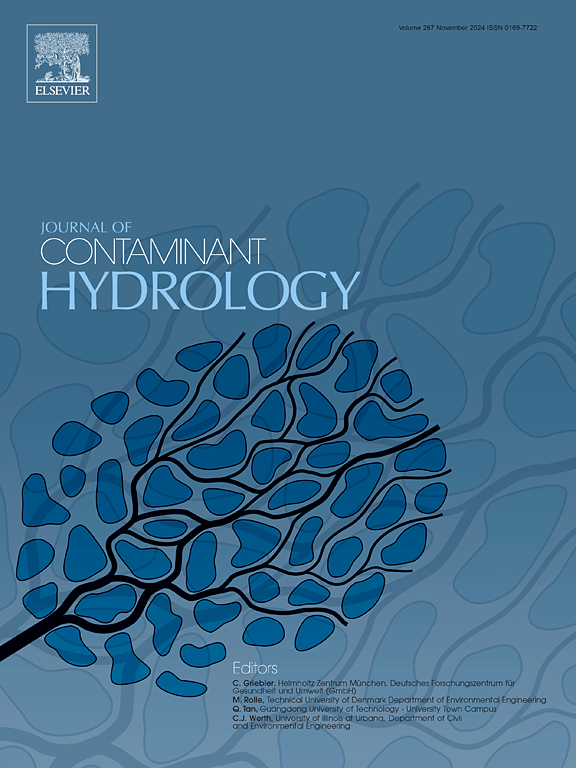Geometric tortuosity model of pores in MICP-treated calcareous sand
IF 3.5
3区 环境科学与生态学
Q2 ENVIRONMENTAL SCIENCES
引用次数: 0
Abstract
In island reef reclamation, Microbially Induced Carbonate Precipitation (MICP) is often used to solidify calcareous sand. Processes such as precipitation can form freshwater storage zones within the solidified areas. The tortuosity and corresponding Representative Elementary Volume (REV) of these zones are crucial for understanding water flow transport in MICP-solidified calcareous sand (MSCS). However, there is currently a lack of quantitative characterization of tortuosity in MSCS. Therefore, this study establishes a geometric tortuosity model for MSCS based on characteristics such as calcium carbonate cementation mode, porosity, calcium carbonate size, and sand particle arrangement. The results show that porosity has a significant impact on the tortuosity of MSCS; specifically, as porosity increases, tortuosity first decreases rapidly and then levels off. An increase in calcium carbonate particle size, a decrease in the spacing between calcareous sand particles, and an increase in the misalignment angle between particles all lead to increased tortuosity, extending the water flow path. The calculated results of the established geometric tortuosity model for MSCS align well with the simulated tortuosity values. Compared to previous literature, the trend of changes in MSCS is consistent, but the tortuosity values are higher than those of single sand particles. This indicates that the proposed geometric tortuosity model for MSCS is more suitable for accurately describing the flow path tortuosity in MICP-solidified island reef freshwater storage zones and understanding the corresponding water flow migration characteristics.

micp处理钙质砂孔隙的几何扭曲模型
在岛礁填海中,微生物诱导碳酸盐沉淀(MICP)常用于钙质砂的固化。诸如降水之类的过程可以在固化区域内形成淡水储存区。这些层段的弯曲度和相应的代表性基本体积(REV)是理解mmic固化钙质砂(MSCS)中水流输运的关键。然而,目前缺乏MSCS扭曲的定量表征。因此,本研究基于碳酸钙胶结方式、孔隙度、碳酸钙粒径、砂粒排列等特征,建立了MSCS的几何扭曲度模型。结果表明:孔隙率对MSCS的扭曲度有显著影响;具体来说,随着孔隙度的增加,弯曲度首先迅速下降,然后趋于平稳。碳酸钙粒径的增大、钙质砂颗粒间距的减小以及颗粒间的不对中角的增大均会导致弯曲度的增大,从而延长水流路径。所建立的MSCS几何弯曲度模型的计算结果与模拟的弯曲度值吻合良好。与以往文献相比,MSCS的变化趋势是一致的,但挠度值高于单个砂粒。这表明所建立的MSCS几何扭曲度模型更适合于准确描述MSCS固化岛礁淡水储存区的流道扭曲度和理解相应的水流迁移特征。
本文章由计算机程序翻译,如有差异,请以英文原文为准。
求助全文
约1分钟内获得全文
求助全文
来源期刊

Journal of contaminant hydrology
环境科学-地球科学综合
CiteScore
6.80
自引率
2.80%
发文量
129
审稿时长
68 days
期刊介绍:
The Journal of Contaminant Hydrology is an international journal publishing scientific articles pertaining to the contamination of subsurface water resources. Emphasis is placed on investigations of the physical, chemical, and biological processes influencing the behavior and fate of organic and inorganic contaminants in the unsaturated (vadose) and saturated (groundwater) zones, as well as at groundwater-surface water interfaces. The ecological impacts of contaminants transported both from and to aquifers are of interest. Articles on contamination of surface water only, without a link to groundwater, are out of the scope. Broad latitude is allowed in identifying contaminants of interest, and include legacy and emerging pollutants, nutrients, nanoparticles, pathogenic microorganisms (e.g., bacteria, viruses, protozoa), microplastics, and various constituents associated with energy production (e.g., methane, carbon dioxide, hydrogen sulfide).
The journal''s scope embraces a wide range of topics including: experimental investigations of contaminant sorption, diffusion, transformation, volatilization and transport in the surface and subsurface; characterization of soil and aquifer properties only as they influence contaminant behavior; development and testing of mathematical models of contaminant behaviour; innovative techniques for restoration of contaminated sites; development of new tools or techniques for monitoring the extent of soil and groundwater contamination; transformation of contaminants in the hyporheic zone; effects of contaminants traversing the hyporheic zone on surface water and groundwater ecosystems; subsurface carbon sequestration and/or turnover; and migration of fluids associated with energy production into groundwater.
 求助内容:
求助内容: 应助结果提醒方式:
应助结果提醒方式:


